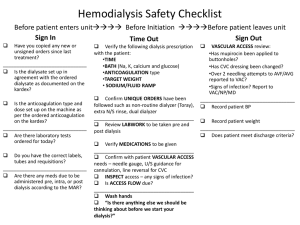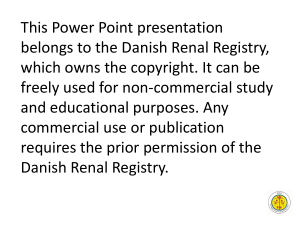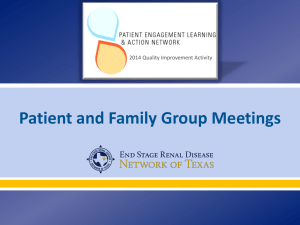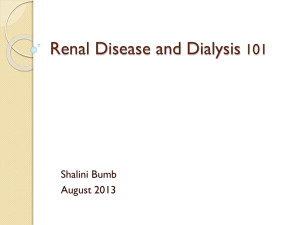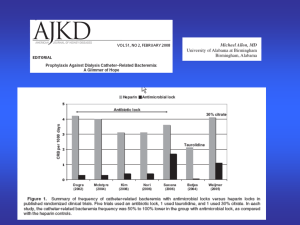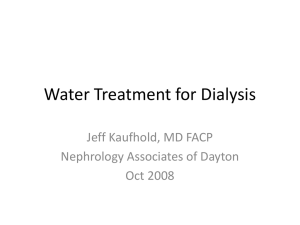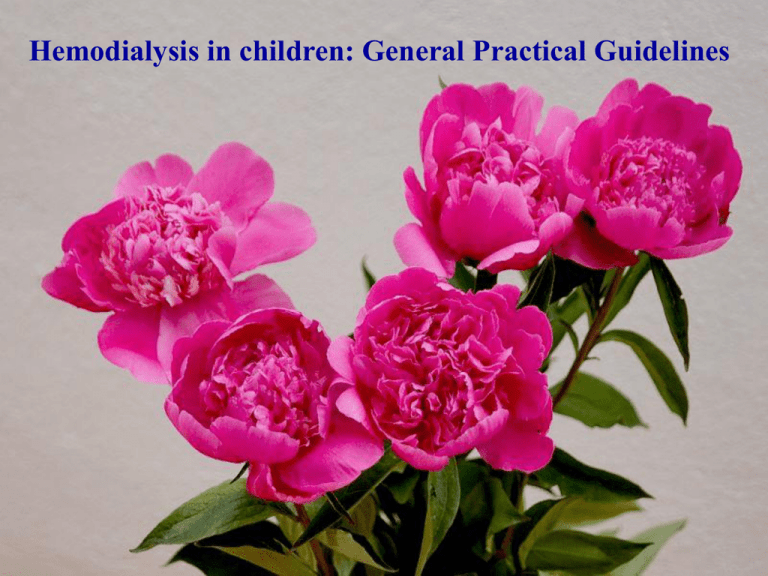
Hemodialysis in children: General Practical Guidelines
Introduction
Hemodialysis in children progress over the last 20 years
The morbidity of the sessions has decreased
Technological progress, the availability of erythropoietin and of
growth hormone enhanced dialysis dose increased quality of life
Technically all children can underwent HD even infants
Primary renal diseases leading to chronic renal failure
France%
North America%
Iran%
GN
25.6
24.8
10.2
Malformation
25.6
34.1
47
Inherited Renal
Disease
16.7
13.5
21.1
CIN
18.8
7
9.6
Vascular Disease
2.2
4.4
3.6
Unknown
11.1
16.2
8.5
Primary Diagnosis
Comprehensive pediatric Nephrology 2008
Pediatric Nephrology Journal 2001
Indication of RRT and Dialysis
Renal Function, GFR?, before uremic symptoms
Fluid status
Biochemical abnormalities
No well being: physical and psychological
Growth retardation
Acute Renal Failure
Oligoanuria, resistant volume overload, hyperkalemia,
mAc, uremic encephalopathy, uremic pericarditis, TLS
with uric acid ≥10, Inborn metabolic syndromes,
Intoxication, BUN
Guideline
Guideline1:
1:The
the dialysis
Dialysisunit
Unit
Taking care of a child with ESRF
necessitates an engaged team consisting of
doctors, nurses, dietician, psychologist,
school teacher, play therapist, and social
worker (second family or support team)
Nutrition, growth, and educational support
are of major importance
Hemodialysis: a frequency of three times per
week for most patients. This frequency may be
increased in babies and/or adolescents requiring
“more dialysis”
Guideline1:2:the
Water
Quality
Guideline
dialysis
unit
Blood contact with 120 cc water during
a dialysis sessions
adequate in terms of biochemical
composition
Free from microbiological
contamination (germs and endotoxins)
Pure versus ultra pure water (High Flux, High
flow hemofiltration, conventional HD?)
Guideline
3: 1:
The
Dialysis
Machine
Guideline
the
dialysis
unit
Specific Feature that are necessary in a
pediatric hemodialysis machine
Precise control of ultrafiltration volumetric assessment
Capable of low blood flow speeds
Ability to use lines of varying blood volums
Measure and remove very small amounts of fluids
Continuous blood volume monitoring during the session
Buffered bicarbonate
Specific material available for babies/infants
Guideline
4: blood
lines unit
Guideline
1: the
dialysis
Available in infants/babies size
High biocompatible material
Guideline 5:
of blood
Guideline
1:principles
the dialysis
unit
purification
Guideline
6:1:
extracorporeal
Guideline
the dialysis blood
unit
access and circulation
Extracorporeal blood flow rate and volume
150–200 mL min−1 m−2
5–7 mL/min/kg up to 8 cc/kg/min
(BW+10)×2.5=QB (mL min−1) in small infants
Arterial blood aspiration pressure : 150–200 mmHg to
limit endothelial trauma
The venous return pressure should not be more than
+200 mmHg to prevent endothelial vascular trauma
The total extracorporeal blood volume : 7- 10 % of
patient total blood volume (<8cc/kg)
System priming with saline, albumin, and blood
Double-needle technique: standard, single needle with
double pump system: alternative
Anticoagulation in the extracorporeal circuit
Infants and small children are sensitive to
anticoagulation because of cerebral hemorrhage
Conventional, heparin: continuous infusion of 20 to
30 IU kg/ h through arterial line, or 25-50 u/kg loading
dose and 10u/kg/hr.
Clotting time is the best monitor for heparin dose in first
dialysis (1.25-1.5 Nl range, PTT: 120-160)
Low-molecular-weight heparin at 1 mg/kg as a bolus at
the beginning of the dialysis session, bleeding,
improved lipid metabolism, half life, cost
Citrate anticoagulation especially with acute dialysis, IV
calcium at venous line 0.3-0.5 mmol/l
Heparin free dialysis, minimal heparinization
TPA 1mg/ml for one hour preferably overnight
Vascular Access
Catheters (cuffed, uncuffed), AV Fistula, AV
Graft
The type of access depending on :
Factors in different units and countries, surgical
experience, patient age and size, the time
available before dialysis, the waiting time before
transplantation, and patient choice
Tunneled cuffed catheter for short term HD
Fistula vascular access is preferred for long-term
chronic hemodialysis
-
* The types of vascular access:
- Catheter:
*Rt/Lt Int jugular> femoral>subclavian, 8-12 F
*Double lumen cuffed/uncuffed catheter, 8 French
*In small infants a single lumen catheter with the
alternative clamps technique
*Complications is more common in children than
adults
*Real time Ultrasound
*Cathetr malfunction: kinking versus intraluminal
thrombosis
-AV Fistula
>25 kg in some centers and >10 kg in centers with microsurgery
Preoperative evaluation and protection of the vessels, upper limb
venography, hydrated and above dry weight and adjustment of
antihypertensive drugs, prophylactic ASA (1-5mg/kg/day)
Selection of vein: 4 mm diameter with 40 mmHg cuff
The time for venous development depends on the age and the
place of the AVF (distal or proximal).
Usually 4-6 wk for maturation, in young children, less than 15 kg,
the time needed to develop a fistula before it can be used could be
some months (up to 4 mo)
Complications: Thrombosis, Infection, Stenosis
(recirculation>10%), Aneurysm, neuropathy, CHF
Recirculation% = S-A/S-V ÷100
2/3 is functional after 4 years
Distal fistuals more complicated in children
AV Graft
Rarely used in children
Complication: stenosis and thrill, clotting,
Infection with difficulty in eradication
Straight Graft in small children and loop Graft
in larger patients
Long term complications is high in children
Guideline
7: which
dialyzer
membrane
Guideline
1: the
dialysis
unit
to “choose”
The choice of a dialyzer membrane should take into
account the following
Type of membrane: biocompatibility toward complement system
Initial blood volume needed, i.e. area-related
Molecular permeability: Highly permeable membranes give the
theoretical potential for middle-molecular-weight
Hydraulic permeability (CUF) : High flux vs low flux
high flux membranes need ultrapure dialysate
Surface area (0.25-1.7): no more infant surface area
Cost
improved removal of middle molecules by high flux, large pore,
biocompatible membranes : reduction of uremia related amyloidosis,
inflammation, malnutrition, anemia, dyslipidemia, and mortality.
Guideline
thedialysis
dialysate
Guideline
1:8:
the
unit
Bicarbonate buffered (35 meq/l)
low calcium level (1.25-1.5 mmol L−1)
glucose concentration at physiological level: 1 gr/l
(prevent cellular potassium shift)
“Zero”, “low” (1–1.5 mmol/l), “normal” (2–2.5 mmol/l),
and “high” (3–3.5 mmol/l) potassium dialysate
Sodium concentrations:138 to 144 mmol/l (difference:
10-15 mmol/l), hypernatremia, change during a
dialysis (sodium modeling)
The dialysate FR 300 to 800 mL min−1 (1.5 BFR).
Thermal degree: 34.5-37, Dialytic thermal exchanges,
for babies and/or high-flow dialysate use
Dialysate quality control (germs and endotoxins) is
required
Guideline
9: post-dialytic
dry unit
weight
Guideline
1: the dialysis
assessment and adjustment
Difficult to define in growing children especially infants
-Hypotensive tendency during a dialysis (plasma refilling
rate capacity)
-Total body water ratio to total body mass, is variable
with age, especially during infancy and puberty
need for regular assessment in a growing child
Monthly in infants, anabolic conditions (GH), Catabolic
conditions (low intake, illness)
close collaboration with pediatric renal dietician
no “unique” optimum method, importance of a clinical
“pediatric” experience
-assessment of TBW by bioelectrical impedance analysis,
continuous measurement of hematocrit by non-invasive
methods during dialysis, plasma ANP or cyclic
guanosine monophosphate determination, by
echography of the inferior vena cava (IVC) diameter of
the IVC (IVCD), An IVCD between 8.0 and
11.5 mm m−2 and a collapse index between 40 and 75 %
is considered as representing normovolemia
-crash hematocrite, Flat HCT curve, more precise
Guideline
10:1:urea
Guideline
the dialytic
dialysiskinetic,
unit
dialysis dose, and protein intake
assessment (nutrition)
In children the criteria of adequate hemodialysis
is not clear as adults
Growth and development is the most important
indicator of adequate dialysis
Urea kinetic modeling (UKM) , A marker of
middle molecules?, increasing urea clearance
above accepted target, underdialyzed patients
and dietary compliance
normalized protein catabolic rate (nPCR)
Urea dialytic reduction rate (URR)
+URR is proportional to dialysis efficiency, and thus to
urea dialytic clearance.
+The ratio post/pre ≤ 0.35 and the difference between
pre and post-urea, divided by the pre dialysis value≥
0.60
Kt/V :dialyzer urea clearance (K) multiplied by
duration (t) of the dialysis session and divided by
urea volume (V) of distribution
+A minimum single pool Kt/V level of 1.2–1.4 : desirable
+ in small children single pool Kt/V more than 1.4
Formulas enabling calculation of the volume of
distribution of urea in liters (total body water) using
height, weight, sex and age
Boys:
Ht<132.7 cm, V=1.927+0.465/BW (kg)+0.0045/ht (cm)
Ht>132.7 cm, V=−21.1933+0.406/BW (kg)+0.209/ht (cm)
Girls:
Ht<110.8 cm, V=0.076+0.507/BW (kg)+0.013/ht (cm)
Ht>110.8 cm, V=-10.313+0.252/BW (kg)+0.154/ht (cm)
Guideline
11: dialysis
and outcome
Guideline
1: the dose
dialysis
unit
Hemodialysis prescription for children: adequate,
before optimum
Blood pressure control, normal myocardial morphology
and function
urea dialysis dose, removal middle molecules and overall
phosphate, a minimum Kt/V level of 1.2–1.4 : desirable,
urea clearance 3-4cc/kg/min
Dialysis frequency and duration : adjusted to the
tolerance of ultrafiltration to reach the dry weight.
UFR=W-Wd+I/T, UFR=TMP×KUF
Ultrafiltration rate should not exceed 1.5±0.5% of body
weight per hour (in theory no more than 5% BW loss
per whole session). 10cc/kg/hr as safe starting point for
water removal. No more than 0.2 cc/kg/min
Hemodialysis prescription for children: adequate,
before optimum
A regular diet
Too fast ultrafiltration (more than 5% BW)
hypotension and cramps during the second half time
session, and fatigue and/or hang over after dialysis
A small solute, e.g. urea, clearance which is too high is a
factor of disequilibrium syndrome usually after the first
half/or one hour session time with headache, even
seizures, nausea, vomiting, sleepiness or a hypertensive
tendency with a narrow range between systolic and
diastolic pressure values. Symptoms usually disappear a
few hours after the end of the dialysis
Guideline 12: the dialysis session, prescription, and
Guideline 1:
the
dialysis
unit
monitoring
Importance of first session:
Pain relief, Emotional support
Prevention of recirculation
First contact with the “extracorporeal” material, dyspnea,
burning heat throughout the body or access site, angioedema,
flushing or vascular collapse, or with minor symptoms such as
itching, rhinorrhea, lacrymation, urticaria, or abdominal
cramping). Prevention: Biocompatible membranes, steamsterilized material, adequate flushing of the circuit
Prevention of disequilibrium syndrome
-The BFR should be ≤ 3 mL kg−1 BW (or 90 mL m−2)
-Short dialysis time (less than 2 hr)
-Mannitol infusion (0.5- 1 g kg/ BW/ 1 to 2 h during dialysis)
- Urea clearance: 1.5-2 cc/kg/min
- Sodium modeling
-selection of dialyzer
-
-
Hemodynamic assess (asymptomatic and without
compensation)
Movement of fluid from extracellular to the
Intracellular space
Impaired sympathetic activity
Vasodilation due to warm dialysate
Splanchnic pooling of blood while eating during dialysis
Excessive UF
Antihypertensive agents
Low Diasylate sodium
Symptoms of hypotension: pallor, cyanosis, vomiting, irritability,
drowsiness, sudden cry, sweating, headache, Seizure, check BP at 1
hr +monitoring + pulse oximetry: children <20 kg
Next sessions
Usually a blood flow rate of 150 to 200 mL/ min/ and
three sessions per week for 3 to 4 h per session achieve
the minimum target prescription of 1.2 to 1.4 Kt/V
The duration of a dialysis session is often prescribed to
reach the anticipated dry weight at the end of the
session, DSA/BSA × Dialysis Index (13-18)
Continuous blood volume monitoring during the session
for ultrafiltration tolerance (with crash HCT)
Intensified HD: 6-8 HR/3-7/WK, 2-3 HR/5-7/WK:
chronic fluid overload, ph, poor growth, infancy
A weight gain over 10% dry BW during the interval of
two sessions: Non compliance
optimum dialysis obtained with longer (4 and
more hours) and/or more frequent (daily: 5 to 6)
sessions to achieve phosphate purification and
maintain the calcium×phosphorus product in the
optimum range of 3.3 to 4.4 mmol/mL and in
following patients:
Infants, Malnutrition, Growth retardation, chronic
overhydration, Intractable HTN, LVH, Primary
hyperoxaluria
Injections during Dialysis
Albumin: small boluses through arterial line at the
beginning of dialysis
Blood: small boluses at the beginning of dialysis
blood required (ml): weight (kg) × 3 × grams of Hb is to be raised
EPO: More dose in infants and children and IV
Complications
• Intradialytic Hypotension
• Disequilibrium
• Hemolysis
-Overheating, contamination, Hypotonicity, Kinking of lines,
pump malfunction
- Dialysis should be stopped and potassium checked immediately
-pains, nausea, dark appearance of venous blood
• Air Embolism
Rare, one ml/kg is fatal, fitting and coma in upright
patient and chest symptoms in recombinant patient
Head Down, left lateral position and 100% oxygen,
Aspiration from the ventricle
• Anaphylaxis
+First use syndrome, prevention by dialyzer
reuse and predialysis rinsing or dialyzer change
in severe reactions
+Stop dialysis and blood should not be retained
to patient
+Normal saline, Epinephrine (SC, IM),
Hydrocoprtisone
• Amyloidosis
Unusual in children, 7-10 yr after HD clinically
جهان يادگار است و ما رفتني به گيتي نماند مگر مردمي
كس ي كو گذشت از ره مردمي زديوان شمر ،مشمرش زآدمي
فردوس ي

